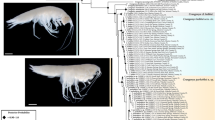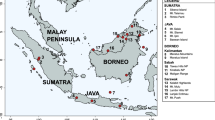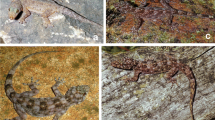Abstract
Populations of two common enteropneusts, Saccoglossus bromophenolosus King et al., 1994 and S. kowalevskii (Agassiz 1873) were sampled between 1991 and 1993 from the southern and northern extremes of their respective ranges: Nova Scotia/Maine and Padilla Bay, Washington for S. bromophenolosus and Maine/South Carolina for S. kowalevskii. Though previously considered a single species, the two taxa were clearly distinct biochemically and genetically. Four of five allozyme loci were diagnostic and indicative of differentiation at the species level. Sequence divergence (27%) of a portion of the mitochondrial 16S rRNA gene suggests that the two taxa have been genetically isolated for a considerable time; hybridization was not evident in sympatric populations. Both taxa contained high concentrations of bromoorganics. The constant association of bromophenols and bromoindoles with S. bromophenolosus and bromopyrroles with S. kowalevskii when they occur sympatrically indicates that bromoorganic contents were genetically and not environmentally determined. Consistent associations between external morphology and bromoorganic contents for additional saccoglossid species support the use of bromoorganics as indices of evolutionary clades in the Enteropneusta.
Similar content being viewed by others
References
Agassiz A (1873) The history of balanoglossus and tornaria. Mem Am Acad Arts Sci IX:421–429
Ahern TJ, Allan GG, Metcalf DG (1980) New bromoperoxidases of marine origin. Partial purification and characterization. Biochim Biophys Acta 616:329–339
Ashworth RB, Cormier MJ (1967) Isolation of 2,6-dibromophenol from the marine hemichordate Balanoglossus biminiensis. Science, NY 155:1558–1559
Avise JC (1974) Systematic value of electrophoretic data. Syst Zool 23:465–481
Avise JC (1994) Molecular markers, natural history and evolution. Chapman and Hall, New York
Azatiah J, Rao VNR, Sridharan VT (1978) Effect of the epidermal secretions of hemichordate, Ptychodera flava on growth of Amphora coffeaeformis and Cyclotella meneghiniana (Diatoms). Proc Indian natn Sci Acad 87:145–149
Bakus GJ, Targett NM, Schulte B (1986) Chemical ecology of marine organisms: an overview. J chem Ecol 12:951–987
Barrington EJW (1965) The biology of hemichordata and protochordata. WJ Freeman Co., San Fransisco
Burdon-Jones C (1952) Development and biology of the larva of Saccoglossus horsti (Enteropneusta) Phil Trans Soc Lond, (Ser B) 236:553–590
Burdon-Jones C, Patil AM (1960) A revision of the genus Saccoglossus (Enteropneusta) in British waters. Proc Zool Soc Lond 134:633–645
Carey DA, Farrington JW (1989) Polycyclic aromatic hydrocarbons in Saccoglossus kowalewskyi (Agassiz). Estuar cstl Shelf Sci 29:97–113
Carey DA, Mayer LM (1990) Nutrient uptake by a deposit-feeding enteropneust: nitrogenous sources. Mar Ecol Prog Ser 63:79–84
Chen YP, Lincoln DE, Woodin SA, Lovell CR (1991) Purification and properties of a unique flavin-containing chloroperoxidase from the capitellid polychaete Notomastus lobatus. J Biol Chem 266:23909–23915
Colwin AL, Colwin LH (1953) The normal embryology of Saccoglossus kowalevskii (Enteropneusta) J Morph 92:401–432
Colwin LH, Colwin AH (1962) Induction of spawning in Saccoglossus kowalevskii (Enteropneusta) at Woods Hole. Biol Bull mar biol Lab, Woods Hole 123:493
Corgiat JM, Dobbs FC, Burger MW, Scheuer PJ (1993) Organohalogen constituents of the acorn worm Ptychodera bahamensis. Comp Biochem Physiol 106(B):83–86
Davis BM (1908) The early life history of Dolichoglossus pusillus Ritter. Univ Calif Publs Zool 4:187–226
Day AJ, Bayne BC (1988) Allozyme variation in populations of the dog-whelk Nucella lapillus (Prosobranchia: Muricacea) from the South West peninsula of England. Mar Biol 99(1):93–100
Dobbs FC, Guckert JB (1988) Microbiol food resources of the macrofaunal-deposit feeder, Ptychodera bahamensis (Hemichordata: Enteropneusta). Mar Ecol Prog Ser 45:127–136
Duncan PB (1987) Burrow structure and burrowing activity of the funnel-feeding enteropneust Balanoglossus aurantiacus in Bogue Sound, North Carolina, USA. Mar Ecol Naples 8:75–95
Emrich R Weyland H, Weber K (1990) 2,3,4-tribromopyrrole from the marine polychaete Polyphysia crassa. J nat Products (Lloydia) 53:703–705
Fenical W, Pawlik JR (1991) Defensive properties of secondary metabolites from the Caribbean gorgonian coral Erythropodium caribaeorum. Mar Ecol Prog Ser 76:1–8
Fielman KT, Targett NM (1995) Variation of 2,3,4-tribromopyrrole and its sodium sulfamate salt in the hemichordate Saccoglossus kowalevskii (Enteropneusta). Mar Ecol Prog Ser 116:125–136
Garson MJ, Manker DC, Maxwell KE (1989) Novel bromo metabolites from a dictyoceratid sponge of the Cacospongia genus. Aust J Chem 42:611–622
Goerke H, Weber K (1990) Locality-dependent concentrations of bromophenols in Lanice conchilega (Polychaeta: Terebellidae). Comp Biochem Physiol 97B:741–744
Gosner KL (1979) A field guide to the Atlantic seashore. Houghton Mifflin Co., Boston
Graf G (1989) Benthic-pelagic coupling in a deep-sea community. Nature, Lond 341:439–441
Higa T, Fujiyama T, Scheuer PJ (1980) Halogenated phenol and indole constituents of acorn worms. Comp Biochem Physiol 65B:525–530
Higa T, Okuda RK, Severns RM, Scheuer PJ, He C-H, Changfu X, Clardy J (1987) Unprecedented constituents of a new species of acorn worm. Tetrahedron 43:1063–1070
Higa T, Sakemi S-I (1983) Environmental studies of natural halogen compounds. I. Estimation of biomass of the acorn worm Ptychodera flava Eschscholtz (Hemichordata: Enteropneusta) and excretion rate of metabolites at Kattore Bay, Kohama Island, Okinawa. J Chem Ecol 9:495–502
Higa T, Scheuer PJ (1975) 3-Chloroindole, principal odorous constituent of the hemichordate Ptychodera flava laysanica. Naturwissenschaften 62:395–396
Jensen P, Emrich R, Weber K (1992) Brominated metabolites and reduced numbers of meiofauna organisms in the burrow wall linings of the deep-sea enteropneust Sterobalanus canadensis. Deep-Sea Res 39:1247–1253
Kimura M (1980) A simple method for estimating evolutionary rate of base substitutions through comparative studies of nucleotide sequences. J molec Evolut 16:111–120
King GM (1986) Inhibition of microbial activity in marine sediments by a bromophenol from a hemichordate. Nature, Lond 323:257–259
King GM (1988) Dehalogenation in marine sediments containing natural sources of halophenols. Appl envirl Microbiol 54:3079–3085
King GM, Giray C, Kornfield I (1994) A new hemichordate, Saccoglossus bromophenolosus (Hemichordata: Enteropneusta: Harrimaniidae) from North America. Proc biol Soc Wash 107:383–390
Kocher T, Thomas WK, Meyer A, Edwards SV, Paabo A, Villablanca FX, Wilson AC (1989) Dynamics of mitochondrial DNA evolution in animals: amplification and sequencing with conserved primers. Proc natn Acad Sci USA 86:6196–6200
Kozloff EN (1987) Marine invertebrates of the Pacific Northwest. University of Washington Press, Seattle
Lansman RA, Shade RO, Shapira JF, Avise JC (1981) The use of restriction endonucleases to measure mitochondrial DNA sequence relatedness in natural populations. III. Techniques and potential applications. J molec Evolut 17:214–226
Mauviel A, Juniper SK, Sibuet M (1987) Discovery of an enteropneust associated with a mound-burrows trace in the deep sea: ecological and geochemcial implications. Deep-Sea Res 34:329–335
Millar DA, Ratcliffe NA (1987) The antibacterial activity of the hemichordate Saccoglossus ruber (Enteropneusta). J Invertebr Path 50:191–200
Milne L, Milne M (1973) Invertebrates of North America. Doubleday, Inc., New York
Moritz C, Dowling TE, Borwn WM (1987) Evolution of animal mitochondrial DNA: relevance for population biology and systematics. A Rev Ecol Syst 18:269–292
Murphy RW, Sites JW Jr, Buth DG, Hanfler CH (1990) Proteins I: isozyme electrophoresis. In: Hillis DM, Moritz C (eds) Molecular systematics. Sinauer Associates, Inc., Sunderland, MA, pp 45–26
Neidleman SL, Geigert J (1986) Biohalogenation: principles, basic roles and applications. Ellis Horwood, Ltd., Chichester, England
Palumbi SR (1992) Marine speciation of a small planet. Trends Ecol Evol 7:114–118
Palumbi SR, Kessing BD (1991) Population biology of the trans-Arctic exchange: mtDNA sequence similarity between Pacific and Atlantic sea urchins. Evolution 45:1790–1805
Paul VJ, Fenical W (1986) Chemical defense in tropical green algae, order Caulerpales. Mar Ecol Prog Ser 34:157–169
Reinhard EG (1942) Stereobalanus canadensis (Spengel), a little-known enteropneustan from the coast of Maine. J Wash Acad Sci 32:309–311
Romero-Wetzel MB (1989) Branched burrow-systems of the enteropneust Stereobalanus canadensis (Spengel) in deep-sea sediments of the Vöring-Plateau, Norwegian Sea. Sarsia 74:85–89
Ruppert EE, Fox RS (1988) Seashore animals of the southeast. University of South Carolina Press, Columbia
Sambrook J, Fritsch EF, Maniatis T (1989) Molecular cloning, 2nd edn. Cold Springs Harbor Lab Press, Cold Springs Harbor, New York
Sheikh YM, Djerassi C (1975) 2,6-dibromophenol and 2,4,6-tribromophenols-antiseptic secondary metabolites of Phoronopsis viridis. Experientia 31:265–266
Solé-Cava AM, Thorpe JP (1991) High levels of genetic variation in natural populations of marine lower invertebrates Biol J Linn Soc 44:65–80
Strathmann M (1978) The length of the pelagic period in echinoderms with feeding larvae from the northeast Pacific. J exp mar Biol Ecol 34:23–27
Thomas IM (1972) Action of the gut in Saccoglossus otagoensis (Hemichordata: Enteropneusta) (NZ Jl Mar) Freshwat Res 6:560–569
Woodin SA, Marinelli R (1992) Biogenic habitat modification in marine sediments: importance of species composition and activity. Proc Zool Soc Lond
Woodin SA, Walla MD, Lincoln DE (1987) Occurrence of brominated compounds in soft-bottom benthic organisms. J exp mar Biol Ecol 107:209–217
Woodwick KH, Sensenbaugh T (1985) Saxipendium coronatum, new genus, new species (Hemichordata: Enteropneusta): the unusual spaghetti worms of the Galapogos Rift hydrothermal vents. Proc biol Soc Wash 98:351–365
Author information
Authors and Affiliations
Additional information
Communicated by J. P. Grassle, New Brunswick
Rights and permissions
About this article
Cite this article
King, G.M., Giray, C. & Kornfield, I. Biogeographical, biochemical and genetic differentiation among North American saccoglossids (Hemichordata; Enteropneusta; Harrimaniidae). Marine Biology 123, 369–377 (1995). https://doi.org/10.1007/BF00353628
Received:
Accepted:
Issue Date:
DOI: https://doi.org/10.1007/BF00353628




